-
Mon 15th Apr 2013 01:19 #1 / 18
In http://www.wargear.net/games/view/257941 I wound up giving a lot of advice about how to play Hex that is likely to be helpful for anyone else who wants to try that board. (I usually have a game on offer for anyone who wants to try it.)
Particularly with this comment:
Here are some tips.
1. Learn what connected chains look like. Build them, recognize them. The fast ones are based on trying to offer the other person a choice of losing options.
2. There are two ways to look at the goal. You are trying to build a chain from one side to the other. You are trying to block the other person from building a chain from one side to the other. They are logically equivalent, but thinking about it the second way helps you try to figure out what the other person is doing.
3. (I got this from another game called "go".) Your opponent's best move is often your best move. Basically if you want to block what your opponent is doing, often the best way to do it is to do what your opponent would like to do. Now they can't do it. If they have 2 good moves, sometimes both moves need a hex in the middle to be empty. Consider going there.
4. Avoid "vulgar" moves. Often you get into natural chains, you go here, I go there, which builds a chain. If that chain goes somewhere you like, the pattern is good. If that chain goes somewhere you don't like, it is bad. It is often easy to recognize early whether it is doing somewhere good or bad. If it is going somewhere good, continue. If it is going somewhere bad, you are just making your life worse, play somewhere else. Your partial position may come in handy later as a threat, or can be resumed after you get a hex somewhere farther along the chain.
5. When in doubt, complicate. Maybe the other person will make a mistake.
If you absorb those rules, you'll be better than the vast majority of people.
-
Fri 3rd May 2013 15:14 #2 / 18
I've been thinking more about the strategy for the game. Here are some of my more detailed thoughts for public consumption. They will start abstract, then become concrete.
1. ALWAYS BLOCK. Tactical tricks center on blocking, not trying to connect. That said, a connected chain blocks all routes across it, so connecting is often a very good way of blocking. (Indeed the only way to block all routes is to connect.) But your goal is always to block.
2. TRY TO BLOCK THE BEST PLAN(S) THAT YOU CAN. Your opponent always has a number of chains that are partly constructed. Decide the plan for your opponent that you think is farthest along towards winning. Find the point in that plan that you think you have the best chance of blocking. (If multiple plans are close, and an area is critical for several of them, play there instead.)
3. EXAMINE SHARED HEXES FOR TACTICS. Often your opponent will have 2 plans that could work out. If you can find a hex that is shared between the logic for those plans, then playing there often leads to a sequence that disrupts both. Try to find that sequence.
4. CONSIDER PLAYING FIRST ON CRITICAL HEXES. If your opponent has an obvious plan, and it requires playing on a particular hex, consider playing there first. If you can spot a tactical trap if you play there, you may want to play one hex over there. But critical hexes are important.
-------
Enough theory, let's see how this allows us to spot common tactical sequences.
Look at a random hex. It has 6 neighbors, which you could build a wall across on. But progress is slow. Call those the slow directions. You can progress this way if need be, but don't want to.
There are 6 hexes that are neighbors of 2 of those neighbors. If you play on those then you've constructed a chain that moves much quicker. Call those the quick directions. Those are the directions that you want to follow to connect things up, because you can complete a chain much faster.
Now let's play the result of following this advice out to try to block a hex. Open up a 19x19 board (the game above was that size) and try to follow along. Suppose that your opponent is trying to connect to the bottom, and has a hex at N14 with nothing else around.
The slow directions (clockwise from the top) are to O_13, O_14, N_15, M_15, M_14, and N_13.
The quick directions (clockwise from the top) are to O_12, P_13, O_15, M_16, L_15, and M_13.
Your opponent's best plans are to follow quick directions to the bottom. The three that move down lead to chains ending at S_19, L_18, and D_19. All three connect to the bottom. Therefore all three have to be stopped. We can't stop them all in one move. Following rule 1, which is best? Clearly the shortest is to L_18 so that is best. From rule 4 we should go on the critical hex, M_16.
Our opponent now has to pick between the two remaining plans.. Let's assume that they jump to L_15. (This is where I would jump, because that is closer to the middle of the wall that I want, hence I'm likely to have more room to play with there.)
From L_15, the opponent has 3 quick chains to the wall. But M_16 is gone because we played there last turn.. Therefore the opponent wants to either continue through K_17 or J_16. But K_16 is needed by both plans. So follow rule 3 and play on K_16.
The opponent therefore plays on L_16 to approach the bottom.
From L_16 there are 3 quick diagonals to the bottom. But we played on K_16 and M_16, which take away 2 of those. Therefore the only plan left is K_18. So play there. Now if your opponent tries to continue moving down, you just build a horizontal wall across. If they push it forever, you'll wind up connecting across on the 18th row and win.
So if you memorize the above 4 rules, and consistently apply them, common simple tactical sequences just naturally fall out. (And your chance of finding complex tactical sequences is greatly improved.)
Good luck! (If you want to try it, you can play a private game with me. Or join the hex tournament that is opening up.)
Edited Fri 3rd May 15:15 [history]
-
 Fri 3rd May 2013 15:23 #3 / 18
Fri 3rd May 2013 15:23 #3 / 18
Thanks for writing this. It would be even better with screenshots (which I know are a lot more work).
-
 Fri 3rd May 2013 16:35 #4 / 18
Fri 3rd May 2013 16:35 #4 / 18
Ozyman wrote:
Thanks for writing this. It would be even better with screenshots (which I know are a lot more work).
If someone wants to supply a version with screenshots, I would be glad to look at it.
I also stopped the sequence before the naive continuation O_15/O_16 (block 2 quick diagonals), N_16/M_18 (block quick diagonal), L_18/oh crap.
Being able to trace out the quick naive response can give you a sense where you might be after a bunch of turns. In this case you'd then realize that you need to back up and do something else at some point. For instance at O_15 instead of the obvious O_16 you should consider N_17 to avoid letting your opponent join up the two lines of play. Then you and your opponent naturally continue with P_16/P_17, O_17/N_19 and you're fine. (Of course a sufficiently clever opponent will see this, and will back up their play somewhere else. Probably to a different section of the board, so that when play returns to this section they have yet another connect to the bottom threat that can be combined with this one, and between them there is yet another tactical trap.)
I don't have a quick guide for when you need to do this kind of analysis, or how to do it well. But it won't be possible to do that analysis unless you can follow the 4 basic rules fast enough to have your tree of possible games only include reasonable continuations.
-
 Fri 3rd May 2013 22:46 #5 / 18
Fri 3rd May 2013 22:46 #5 / 18
I thought your second post was more easy to follow than the first, but that is because I am too lazy to get a board and follow along.
I found this image:
as a kind of example of this:There are 6 hexes that are neighbors of 2 of those neighbors. If you play on those then you've constructed a chain that moves much quicker. Call those the quick directions. Those are the directions that you want to follow to connect things up, because you can complete a chain much faster.
Edited Fri 3rd May 23:01 [history]
-
 Fri 3rd May 2013 23:56 #6 / 18
Fri 3rd May 2013 23:56 #6 / 18
btilly wrote:
1. ALWAYS BLOCK. Tactical tricks center on blocking, not trying to connect. That said, a connected chain blocks all routes across it, so connecting is often a very good way of blocking. (Indeed the only way to block all routes is to connect.) But your goal is always to block.
It's strange, but it's a good suggestion. Technically, connecting is blocking and blocking is connecting. So, ALWAYS CONNECT is just as legitimate a suggestion. (Technically, not psychologically!)
Psychologically, I get into the most trouble when I try to connect. A lot of times it looks like I'm ahead in the connection department, but when I try to see how to force it through, it isn't there! The blocker always seems to have a way to block!
So, don't get too attached to a chain. The blocker usually has a way to stop a chain. No single chain by itself gets through easily.
-
 Fri 3rd May 2013 23:58 #7 / 18
Fri 3rd May 2013 23:58 #7 / 18
A better illustration of the slow directions would be:

And a corresponding image for the quick directions is:

If you can, you generally want to connect/block along a quick direction. But a lot of tactics wind up with you needing to play on the slow direction instead. (Because it can hinder 2 quick directions at once.)
-
 Sat 4th May 2013 00:11 #8 / 18
Sat 4th May 2013 00:11 #8 / 18
On the nitty gritty tactical level, one of the first bits of Hex-thought you want to develop is figuring out where a chain marching in one direction ends up. Drawing a line in your mind's eye, in btilly's slow and quick directions, you can see where a chain will end up. Will it connect to a base if it goes on indefinitely? Based on this, how might you or your opponent stop such a chain? Such thought goes a long way.
-
 Sat 4th May 2013 00:16 #9 / 18
Sat 4th May 2013 00:16 #9 / 18
Hugh wrote:
On the nitty gritty tactical level, one of the first bits of Hex-thought you want to develop is figuring out where a chain marching in one direction ends up. Drawing a line in your mind's eye, in btilly's slow and quick directions, you can see where a chain will end up. Will it connect to a base if it goes on indefinitely? Based on this, how might you or your opponent stop such a chain? Such thought goes a long way.
Exactly.
In general if there is just one direction going places that work out for your opponent, then you are likely to block on or near the first jump in that direction.
If there are two, then your tactics typically start with playing on the slow neighbor that is needed by both.
-
 Sun 26th May 2013 17:55 #10 / 18
Sun 26th May 2013 17:55 #10 / 18
There is a site for analysis of games that has some interesting Hex games. The games themselves appear to be played at a high level and I presume that these people are quite a bit better than I am. Here is a sample:
http://www.trmph.com/hex/game/lg-1022685
http://www.trmph.com/hex/game/lg-1022680
http://www.trmph.com/hex/game/lg-1022682
Some notes:
1) They play like Go players. The opening moves are very spaced out. Motives in the beginning seem very abstract.
2) Though the purpose is to create a single 1D chain across the board, they seem very concerned about 2-dimensional shape.
3) They have no issues abandoning a single chain.
4) Moves that seem to demand a reply are often ignored. In other words, global play trumps local play.
That said, I think many who attempt the game for the first time would be wise to master some of the simpler techniques mentioned here in this forum before going on to the crazy stuff. But, it's also nice to see that there exists some advanced play out in the world. (Figuring out why it was safe to resign or why obvious replies don't work is a puzzle in itself for a lot of these games!!)
-
 Sun 2nd Jun 2013 20:05 #11 / 18
Sun 2nd Jun 2013 20:05 #11 / 18
One of the first tactics you learn in Hex is the jump:
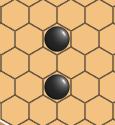
Black's two stones aren't directly connected, but they may as well be. White can't stop Black from connecting the two stones. It's faster than crawling and unstoppable.
A common defending tactic is to try to not allow this move:

Both are good basic tactics that you'll use in a variety of situations, but the moves are essentially local. A bad consequence of using only these moves is that certain stone placements seem unstoppable:
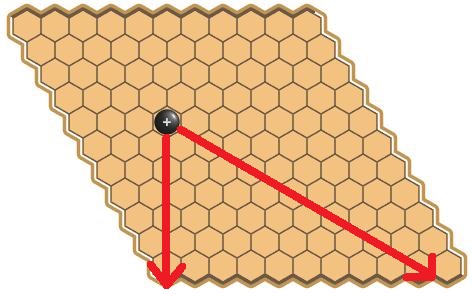
-
 Sun 2nd Jun 2013 20:09 #12 / 18
Sun 2nd Jun 2013 20:09 #12 / 18
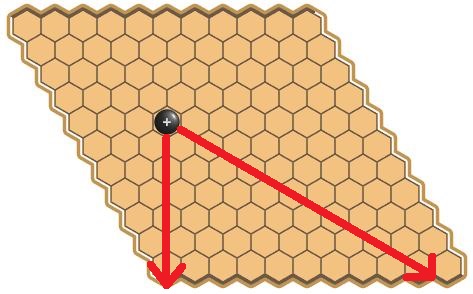
Why does this stone seem unstoppable? If White blocks from below, Black moves diagonally:

If White blocks diagonally, Black just moves down:

If White tries a combination, Black is still fine!
 Edited Sun 2nd Jun 20:17 [history]
Edited Sun 2nd Jun 20:17 [history]
-
 Sun 2nd Jun 2013 20:13 #13 / 18
Sun 2nd Jun 2013 20:13 #13 / 18
So you just use a more complex combination. Block the 1 point jump, when the other person makes the other, then play right next to them. When they play between your two, block the 1 point jump again and start building a wall across.
Alternately play next so that they can't connect either jump, and then when they try to crawl around, block a 1 point jump and start building across.
Knowing about alternatives matters a lot because sometimes one will be better than the other. :-)
-
 Sun 2nd Jun 2013 20:14 #14 / 18
Sun 2nd Jun 2013 20:14 #14 / 18
But Hex offers more than just the move straight across as a block. The following is a common blocking scheme. Instead of going straight across, White gets in Black's face!
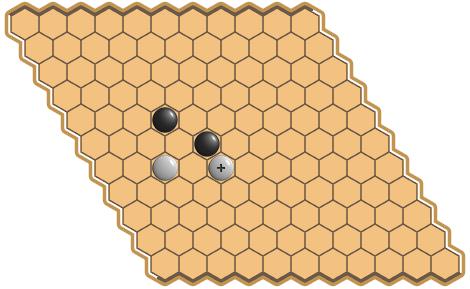
It looks like Black can sneak through that hole.
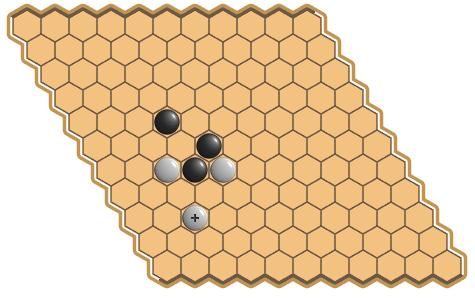
But now it is Black who has to contend with a pattern that looks unstoppable:
 Edited Sun 2nd Jun 20:17 [history]
Edited Sun 2nd Jun 20:17 [history]
-
 Sun 2nd Jun 2013 20:16 #15 / 18
Sun 2nd Jun 2013 20:16 #15 / 18
Alternatively, White can play from a distance:

Now Black's short hops are not effective:
 Edited Sun 2nd Jun 20:18 [history]
Edited Sun 2nd Jun 20:18 [history]
-
 Sun 2nd Jun 2013 20:24 #16 / 18
Sun 2nd Jun 2013 20:24 #16 / 18
All of the plays of the last few posts are fairly local and do not demonstrate how you would think about a complex position. I don't really know who was winning or losing. It was just to show how there are usually options, more than you might imagine by constraining your thought to a small set of moves. Simple trends, consisting of just jumps and crawls usually can be stopped.
-
 Sun 2nd Jun 2013 20:53 #17 / 18
Sun 2nd Jun 2013 20:53 #17 / 18
Another one of my favorite local themes is the slightly extended jump:
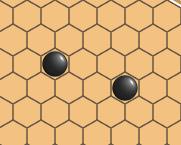
Unlike the straight across jump, this can be blocked. White can block at one of the marked spots:
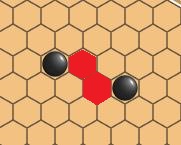
But there is a cost to disconnecting these two stones. Black can get some momentum in one direction by sacrificing one of the stones:
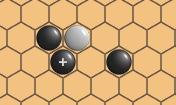
When White completes the disconnect, Black has a nice chain of 4 stones:

White gets to choose the stone to disconnect and where the black wall is made. There are other ways to utilize the extended jump than this, but this is one of the ways it plays out.
Edited Sun 2nd Jun 20:54 [history]
-
 Sun 2nd Jun 2013 21:09 #18 / 18
Sun 2nd Jun 2013 21:09 #18 / 18
Finally, I thought I'd show my new favorite 2-D shape. I like it a lot. It's still local and you can't really force it upon an opponent because it consists of 4 stones. The opportunity does sometime arise, though. Go has a similar shape, often called a table:

These stones are connected!!! The nice part about a 2D shape is that its influence extends in more than just one direction and from more than one stone. Here are some basic attempts by White to disconnect the shape and Black's replies.
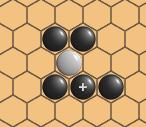

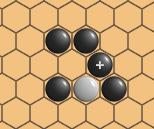
While you shouldn't just go about trying to make shapes like this, it's very pleasing when it fits nicely into some larger plan. From what I can tell of more advanced play, these local plays are part of the basic language of the game, but ultimately, a good strategy must be global in nature. This stuff is the tactics.
Edited Sun 2nd Jun 21:10 [history]






